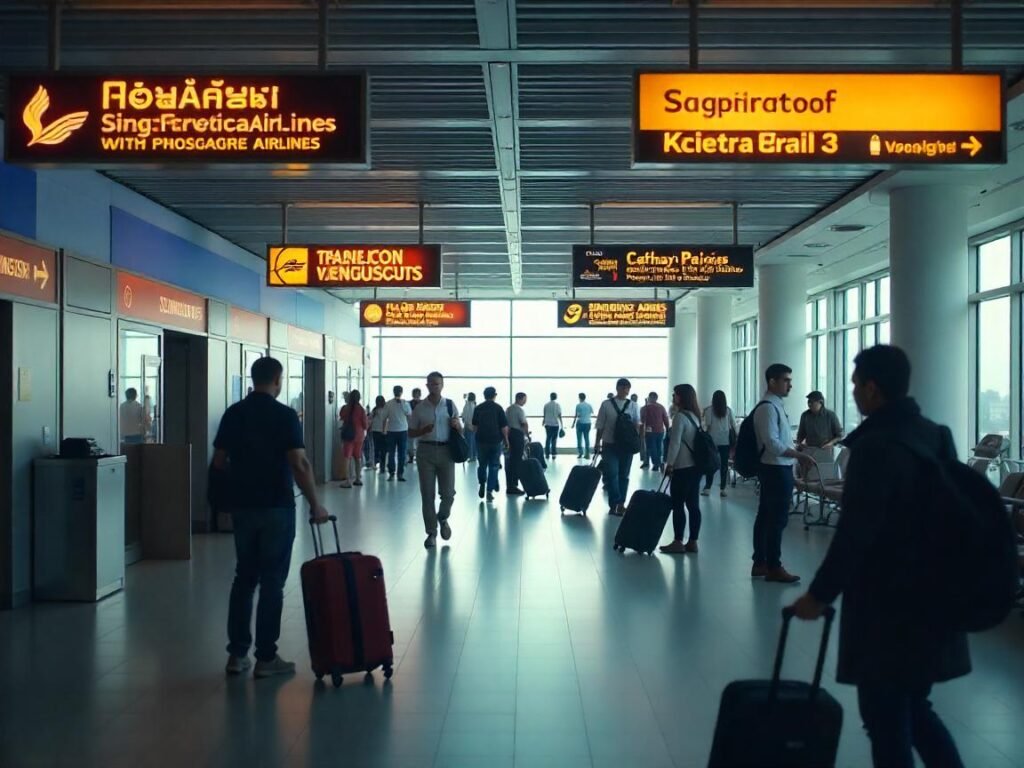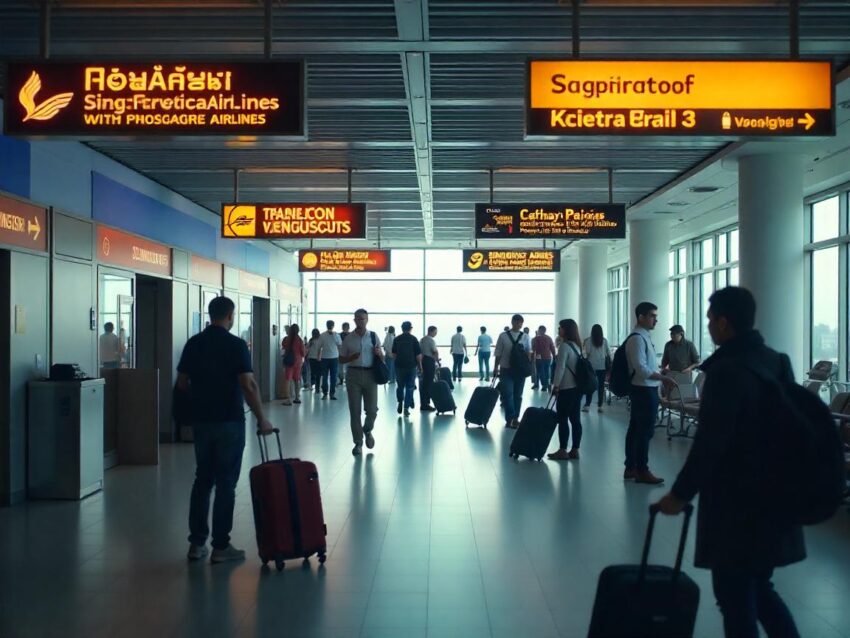
Sunday, June 22, 2025

Southwest is making waves once again—and this time, it’s not alone. Southwest has officially joined forces with major international airlines like Singapore Airlines, Thai Airways, Korean Air, Asiana, Cathay Pacific, and HK Express in rolling out a series of new rules for passengers. These rules are already shaking up travel plans, and they’re coming just in time to affect your Fourth of July Independence Day holiday trip.
Yes, you read that right. Southwest, known for its no-frills flying, is now taking cues from Singapore Airlines and Thai Airways, as well as Korean Air and Asiana. Meanwhile, Cathay Pacific and HK Express have already enforced their own strict passenger policies. Together, this collective move signals something bigger than just a policy update—it’s a global shift in how passengers fly, pack, and prepare.
So what’s really changing? Why is Southwest joining this elite group, and why now—right before one of America’s biggest travel weekends? The answer isn’t simple. These new rules aren’t just about safety; they’re about control, risk management, and a brand-new flying experience.
As you start planning that perfect Fourth of July getaway, don’t get caught off guard. You need to know what Southwest and these leading international carriers are doing, and how it will impact your seat, your bags, your chargers—and maybe even your whole travel routine.
The full guide is here. Read on before you board. Because this year, even your favorite airline might surprise you.
Southwest Airlines Drops Bombshell Changes That Could Reshape Budget Flying in the US
Southwest Airlines, once a maverick among U.S. carriers, is rewriting the rules of low-cost flying—and the ripple effects could shake the entire industry.
In a sweeping set of policy changes, Southwest has begun eliminating long-standing benefits that made it one of the most beloved airlines among budget-conscious travelers. From ending free checked baggage to implementing assigned seating for the first time, the airline is entering a new era—and not everyone is cheering.
These aren’t small tweaks. These are fundamental changes that redefine what Southwest has stood for over the last few decades.
Free Bags No More: The Policy That Made Southwest Stand Out Is Gone
As of May 28, 2025, Southwest quietly ended its policy of allowing all passengers to check bags for free. This once-iconic perk made the airline the go-to option for millions who wanted transparency and affordability without being nickel-and-dimed for every suitcase.
Now, only select business class and loyalty program members will qualify for free checked luggage. Everyone else will have to pay.
The change has hit frequent travelers and families especially hard. For many, bag fees are a dealbreaker. And for Southwest—once praised for keeping flying simple—it’s a risky move that alters its brand promise.
Charging Ahead: New Rules for Portable Batteries Take Effect
In a less controversial, but still noticeable shift, Southwest has also implemented stricter rules on portable chargers.
Passengers are now required to keep power banks visible and out of luggage while charging devices mid-flight. The new safety measure is intended to reduce the risk of onboard fires caused by lithium-ion battery malfunctions—an issue that has grown in recent years across all airlines.
While logical from a safety standpoint, the new rule adds one more layer of regulation that frequent flyers will need to remember. It’s a small change—but one that reminds passengers that the in-flight experience is evolving fast.
Major Altitude Adjustment: Cabin Prep Starts at 18,000 Feet
Traditionally, most airlines—including Southwest—begin prepping the cabin for landing at 10,000 feet. That’s about when passengers usually notice tray tables going up and devices being stored.
But now, Southwest is shifting that protocol to 18,000 feet, giving crew members more time to manage cabin compliance before landing. The change might go largely unnoticed by the average passenger, but it signals another operational adjustment that’s part of broader efficiency improvements.
Still, when combined with other changes, it paints a clear picture: the airline experience is becoming more controlled, more structured, and less relaxed.
The End of Open Seating: A Signature Perk Fades Away
Perhaps the most seismic shift of all is the scheduled end of Southwest’s open seating policy.
By 2026, Southwest will move to assigned and premium seating—something it has never done in its decades of service. This new approach will begin rolling out in late 2025 when passengers can start booking assigned seats.
Until now, Southwest stood apart by letting passengers choose their seats freely once aboard. It was a policy that created flexibility, encouraged early check-ins, and even built a loyal following who mastered the boarding process.
But that era is now ending.
The airline is presenting the change as an upgrade—offering more control to travelers and positioning it as a premium feature. Still, many longtime customers see it differently. To them, it’s another step toward conformity in a market already crowded with identical offerings.
A Brand Identity in Flux: What Will Southwest Be Known For Now?
Southwest built its reputation on simplicity, value, and a no-nonsense approach to air travel. With no seat fees, no bag fees, and open seating, it felt like a refreshing alternative to competitors.
But with all three of those perks being phased out, passengers are asking: what makes Southwest different anymore?
The airline believes these changes will help it attract new business and corporate travelers who expect assigned seating and don’t mind paying for baggage. However, the risk is clear—alienating the very customers who fueled the company’s rise.
Social media has exploded with divided opinions. Some passengers welcome the structure of assigned seating, tired of the stress and scramble during boarding. Others are dismayed, feeling like the soul of Southwest is being sold off piece by piece.
Strategic or Self-Sabotage? Analysts Are Watching Closely
Industry experts are keeping a close eye on the airline’s earnings, especially after Q3 of 2025. If loyalty metrics and bookings drop, it could force a recalibration. If the changes boost revenue and corporate sales, other budget airlines may follow suit.
What’s certain is this: the legacy of Southwest’s unconventional model is now being rewritten in real time.
This is no longer the airline that breaks the mold. It’s becoming an airline that adapts to it—with all the benefits and drawbacks that brings.
A Turning Point for Budget Air Travel in America
What Southwest Airlines is doing isn’t just a rebrand—it’s a reshaping of how value-based flying is defined in 2025 and beyond.
Other low-cost airlines, from Frontier to Allegiant, are watching this shift closely. If Southwest succeeds in redefining budget travel with new upsells and structure, a wave of similar changes could sweep through the industry.
If it backfires, it could become a cautionary tale on how quickly loyalty can be lost.
Either way, the age of free bags and free choice in the cabin is ending. A new chapter has begun—and travelers across the U.S. will feel it, whether they choose to fly Southwest or not.
Safety First or Too Far? Why Airlines Are Changing the Rules for Every Passenger in 2025
The skies are changing fast—and not just because of new aircraft or routes. In 2025, airlines worldwide are tightening their rules, especially around what passengers can carry on board. From where you place your portable charger to how your lithium battery is stored, the new aviation reality is one of zero tolerance and enhanced safety enforcement.
But what’s really driving these changes? And how do they affect your next trip? The answers reveal an industry responding to new risks and trying to balance convenience with control.
Power Banks Under Fire: A Global Shift in Cabin Safety
It started with a few sparks—literally. Reports of portable chargers catching fire mid-flight have led to sweeping reforms in aviation policies.
In Asia, where some of the strictest rules have emerged, airlines are no longer taking chances. Singapore Airlines and Scoot made headlines by banning in-flight use of power banks altogether. Passengers can bring them aboard, but they cannot charge devices mid-air—a major change for tech-savvy travelers who rely on their devices for entertainment and work.
Meanwhile, China Airlines, Thai Airways, Korean Air, Asiana Airlines, and EVA Air now enforce visibility rules. That means if you’re using a portable charger, it must be out of your bag, in plain sight, and never stowed in overhead compartments during use. Flight attendants now monitor for violations, and non-compliance can result in warnings—or worse.
Air Busan has gone even further. After a power bank-related fire incident earlier this year, the carrier has banned the devices from hand luggage altogether, setting a strict precedent.
Hong Kong Airlines Take Extra Precautions
In Hong Kong, airlines are also stepping up. Cathay Pacific, HK Express, and Hong Kong Airlines have adopted rules that require power banks to be kept under seats or within seat pockets. No exceptions. The move stems from safety audits revealing that even indirect exposure to heat in overhead bins can pose serious fire risks.
These rules may seem excessive to some, but the rationale is clear: preventing cabin fires before they start. In a space where seconds matter, airlines want full visibility and control.
Australia’s Caution: Qantas Gets Proactive
Qantas is no stranger to high safety standards, and it’s now joining the push for better power management on flights. New policy updates mandate that lithium-ion batteries and portable chargers must be removed from checked luggage. Instead, they must be carried in the cabin—where they can be monitored.
It’s a proactive move that prioritizes mid-flight containment. In the rare event that a device overheats, cabin crew can intervene quickly. But once it’s in the cargo hold, the story could end very differently.
Why the Crackdown Now?
Lithium-ion battery incidents on flights have risen in the last two years. According to global aviation authorities, most inflight fires have been linked to improperly stored batteries or unauthorized charging setups. This is especially concerning for airlines that serve long-haul routes, where cabin fires could turn catastrophic in remote airspace.
Moreover, with more travelers now flying with multiple devices—phones, tablets, smartwatches, laptops—the cabin has become a sea of electronics. That means more heat, more energy, and more risk.
Airlines aren’t waiting for regulators to force their hand. Instead, they’re acting quickly to safeguard lives and maintain trust.
What Passengers Need to Know
For the average traveler, these new rules may feel like a lot to keep up with. But knowledge is power—and knowing what’s expected of you can save time and prevent unpleasant surprises.
Here’s what you should remember when flying in 2025:
- Always carry power banks in your cabin bag, never in checked luggage.
- Do not use or charge portable batteries in overhead bins. Keep them visible and accessible.
- Know your airline’s policy—some carriers may have stricter or unique variations.
- Use seat pockets or floor space only when charging, especially on Asian or Australian flights.
- Check airline websites before flying, as rules can evolve without notice.
Mixed Feelings Among Frequent Flyers
While many passengers welcome the extra safety, others worry the rules may go too far. Some feel overwhelmed by the different policies between carriers. Others are frustrated by the loss of mid-air charging, especially during long-haul journeys.
However, most agree that avoiding even one fire risk is worth the inconvenience.
As aviation continues to evolve post-pandemic, safety remains the top priority—and travelers will need to adapt to stay ahead.
Will U.S. and European Airlines Follow Suit?
So far, most of these new policies are concentrated in Asia and Oceania. But industry experts say it’s only a matter of time before U.S. and European carriers adopt similar standards.
The Federal Aviation Administration (FAA) and European Union Aviation Safety Agency (EASA) are already monitoring battery-related incidents closely. If patterns continue, stricter cross-border regulations are likely to follow.
For global travelers, that means preparing for a future where digital convenience comes with much more responsibility—and surveillance.
Final Descent: What This Means for the Future of Flying
The 2025 air travel landscape is one of increasing structure. Portable chargers, once an afterthought, are now a top security concern. Airlines from Singapore to Sydney are responding with clarity and conviction.
For passengers, the new rules are not just about policy—they’re about staying informed and staying safe.
As more airlines update their in-flight rules, travelers must evolve with them. Your carry-on today carries more power than ever before—and with that power comes new rules, new habits, and a new chapter in global aviation safety.







